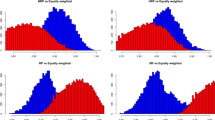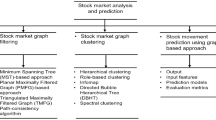Abstract
We introduce a new network-based data mining approach to selecting diversified portfolios by modeling the stock market as a network and utilizing combinatorial optimization techniques to find maximum-weight s-plexes in the obtained networks. The considered approach is based on the weighted market graph model, which is used for identifying clusters of stocks according to a correlation-based criterion. The proposed techniques provide a new framework for selecting profitable diversified portfolios, which is verified by computational experiments on historical data over the past decade. In addition, the proposed approach can be used as a complementary tool for narrowing down a set of “candidate” stocks for a diversified portfolio, which can potentially be analyzed using other known portfolio selection techniques.



Similar content being viewed by others
References
Abello, J., Resende, M. G. C., & Sudarsky, S. (2002). Massive quasi-clique detection. In S. Rajsbaum (Ed.), LATIN 2002: theoretical informatics (pp. 598–612). London: Springer.
Balasundaram, B., Butenko, S., & Hicks, I. V. (2011). Clique relaxations in social network analysis: the maximum k-plex problem. Operations Research, 59, 133–142.
Boginski, V., Butenko, S., & Pardalos, P. (2003). On structural properties of the market graph. In A. Nagurney (Ed.), Innovations in financial and economic networks (pp. 29–45). Northampton: Edward Elgar.
Boginski, V., Butenko, S., & Pardalos, P. (2005). Statistical analysis of financial networks. Computational Statistics & Data Analysis, 48(2), 431–443.
Boginski, V., Butenko, S., & Pardalos, P. (2006). Mining market data: a network approach. Computers & Operations Research, 33(11), 3171–3184.
Bomze, I. M., Budinich, M., Pardalos, P. M., & Pelillo, M. (1999). The maximum clique problem. In D.-Z. Du & P. M. Pardalos (Eds.), Handbook of combinatorial optimization (pp. 1–74). Dordrecht: Kluwer Academic.
Elton, E. J., & Gruber, M. J. (1997). Modern portfolio theory, 1950 to date. Journal of Banking & Finance, 21, 1743–1759.
Grane, A., & Veiga, H. (2010). Wavelet-based detection of outliers in financial time series. Computational Statistics & Data Analysis, 54, 2580–2593.
Harary, F., & Ross, I. C. (1957). A procedure for clique detection using the group matrix. Sociometry, 20(3), 205–215.
Kim, T., & White, H. (2004). On more robust estimation of skewness and kurtosis. Finance Research Letters, 1, 56–73.
Luce, R. D. (1950). Connectivity and generalized cliques in sociometric group structure. Psychometrika, 15(2), 169–190.
Luce, R. D., & Perry, A. D. (1949). A method of matrix analysis of group structure. Psychometrika, 14(2), 95–116.
Luenberger, D. G. (1998). Investment science. New York: Oxford University Press.
Mantegna, R. N., & Stanley, H. E. (2000). An introduction to econophysics: correlations and complexity in finance. Cambridge: Cambridge University Press.
Markowitz, H. M. (1952). Portfolio selection. The Journal of Finance, 7, 77–91.
McClosky, B. (2011) Clique relaxations. In: J. Cochran (Ed.), Encyclopedia of operations research and management science. New York: Wiley.
Mokken, R. J. (1979). Cliques, clubs and clans. Quality and Quantity, 13, 161–173.
Newman, M. (2003). The structure and function of complex networks. SIAM Review, 45, 167–256.
Östergȧrd, P. R. J. (1999). A new algorithm for the maximum-weight clique problem. Electronic Notes in Discrete Mathematics, 3, 153–156.
Pattillo, J., Youssef, N., & Butenko, S. (2013). On clique relaxation models in network analysis. European Journal of Operational Research, 226, 9–18.
Pena, D. (2001). Outliers, influential observations and missing data. In D. Pena, G. Tiao, & R. Tsay (Eds.), A course in time series (pp. 136–170). New York: Wiley.
Seidman, S. B., & Foster, B. L. (1978). A graph theoretic generalization of the clique concept. The Journal of Mathematical Sociology, 6, 139–154.
Shirokikh, O., Pastukhov, G., Boginski, V., & Butenko, S. (2013). Computational study of the U.S. stock market evolution: a rank correlation-based network model. Computational Management Science. doi:10.1007/s10287-012-0160-4.
Trukhanov, S., Balasubramaniam, C., Balasundaram, B., & Butenko, S. (2013, working paper). Exact algorithms for hard node deletion problems in graphs.
Yu, H., Paccanaro, A., Trifonov, V., & Gerstein, M. (2006). Predicting interactions in protein networks by completing defective cliques. Bioinformatics, 22, 823–829.
Author information
Authors and Affiliations
Corresponding author
Rights and permissions
About this article
Cite this article
Boginski, V., Butenko, S., Shirokikh, O. et al. A network-based data mining approach to portfolio selection via weighted clique relaxations. Ann Oper Res 216, 23–34 (2014). https://doi.org/10.1007/s10479-013-1395-3
Published:
Issue Date:
DOI: https://doi.org/10.1007/s10479-013-1395-3




